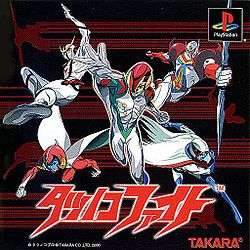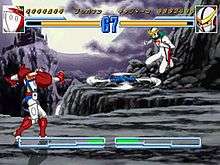Tatsunoko Fight
| Tatsunoko Fight | |
|---|---|
 | |
| Developer(s) | Electronics Application (Eleca) |
| Publisher(s) | Takara |
| Platform(s) | PlayStation |
| Release date(s) |
|
| Genre(s) | Fighting |
| Mode(s) | Single-player, multiplayer |
Tatsunoko Fight (タツノコファイト Tatsunoko Faito) is a fighting video game developed by Electronics Application (Eleca) and published by Takara for the PlayStation game console released in Japan in October 2000. It features characters from various Tatsunoko superhero properties in addition to original creations developed exclusively for the game. Each series is represented by characters, backgrounds, music, and voice actors from the original television programs, along with new art and animated sequences produced by Tatsunoko Production.[1]
Gameplay
Tatsunoko Fight is a two-dimensional, one-on-one fighting game where players must defeat their opponent in two of three rounds in order to advance.[2] The game relies on using both normal and special attacks in order to damage the opponent, with a round ending once all of a character's remaining vitality has been lost. A special gauge at the bottom of the screen steadily fills when a character deals or receives damage, reaching a maximum of three levels. Player's can then expend one level at a time to unleash a more powerful super attack on their opponent to deal more damage. The game uses a combo system where light and heavy attacks can be chained together to launch a succession of attacks that cannot be interrupted or stopped until the sequence ends. In addition to normal versus mode, players may choose a round-robin-style team battle mode involving multiple characters, as well as a single-player story mode that resembles an arcade fighting game.[3]
Characters

Tatsunoko Fight features playable characters from four established Tatsunoko franchises: Science Ninja Team Gatchaman, Neo-Human Casshern, Tekkaman: The Space Knight, and Hurricane Polymar, as well an original series created exclusively for the game, Denkou Senka Volter (電光石火ヴォルター, literally "Lightning Warrior Volter").[4] Each series is represented by three members, consisting of a "Hero", "Supporter", and "Arch Rival" character from their respective titles.[3] Original characters created solely for the game include the superhero Volter, his companion Neon, and their nemesis Karochi Taiki, as well as the game's primary antagonist, the demonic Rosraisen. Many of the game's characters are voiced by the actors who portrayed them in their original animated appearances, with additional supporting characters making cameo appearances throughout gameplay.[5]
| Character | Series | Voice Actor |
|---|---|---|
| Ken Washio the Eagle | Science Ninja Team Gatchaman | Katsuji Mori |
| Jun Shiratori the Swan | Science Ninja Team Gatchaman | Kazuko Sugiyama |
| Berg Katse | Science Ninja Team Gatchaman | Yō Kitazawa |
| Casshern | Neo-Human Casshern | Ikuo Nishikawa |
| Luna Kotsuki | Neo-Human Casshern | Emiko Tsukada |
| Buraiking Boss | Neo-Human Casshern | Kenji Utsumi |
| Tekkaman | Tekkaman: The Space Knight | Katsuji Mori |
| Andro Umeda | Tekkaman: The Space Knight | Nachi Nozawa |
| Doburai | Tekkaman: The Space Knight | Takeshi Kuwabara |
| Hurricane Polymar | Hurricane Polymar | Kazuyuki Sogabe |
| Teru Nanba | Hurricane Polymar | Akiko Hiramatsu |
| Astral Chameleon | Hurricane Polymar | Takeshi Aono |
| Volter | Denkou Senka Volter | Shin-ichiro Miki |
| Neon | Denkou Senka Volter | Hyo-sei |
| Karochi Taiki | Denkou Senka Volter | Yoku Shioya |
| Rosraisen | Original character | Nachi Nozawa |
See also
References
- ↑ "Ask 411 Games 05.31.10: Lost Vikings, Found Games and Child Support Analogies!". 411 Mania. Retrieved 2010-05-31.
- ↑ "PlayStation.com(Japan)/ソフトウェアカタログ/タツノコファイト". PlayStation Japan (in Japanese). 2000. Retrieved 2008-07-21.
- 1 2 Takara (2000). Tatsunoko Fight Instruction Manual (in Japanese). Takara.
- ↑ "Yahoo!ゲーム - タツノコファイト". Yahoo (in Japanese). 2000. Retrieved 2008-07-21.
- ↑ タツノコファイト情報. Tatsunoko Fight Collection (in Japanese). 2002. Archived from the original on February 16, 2007. Retrieved 2008-07-21.